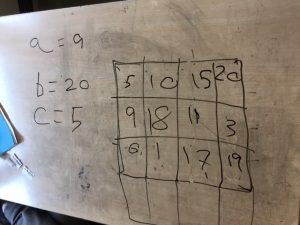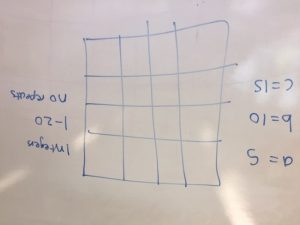by Livia Mitson (May 2020)

I was working with a year 7 class on developing meaning around algebra. We were scheduled to look at like terms, substitution and writing expressions. I wasn’t happy with the traditional way that I had taught it in the past as it seemed to lack opportunities for mathematical thinking. So I bought some ATM books about algebra activities to try to expand my repertoire.
The idea behind this game was that students draw out a bingo grid of 12 (or 16) numbers on the desk, choosing numbers between 1 and 20. On the board I had written a = 9 b = 20 c= 5. I then read out different algebraic expressions and they had to evaluate them and cross off the number. As it was year 7 I mostly used addition and subtraction. This seemed a good activity to build fluency if not any deeper thinking.
However, for the second round of the bingo I asked students to suggest values for a, b and c. They suggested a = 5, b = 10 and c = 15. I spotted some students rapidly changing what numbers they had in their grid – as I’d been using just addition and subtraction some numbers were now considerably more likely to come up than others.

This gave me the idea of using this as a task for mathematical thinking:
If a = 5, b = 10 and c = 15, can you write an expression using only addition and subtraction to make every integer between 1 and 20? E.g. a + b will give 15, c – a will give 10, etc. Your expressions can only use letters.
What numbers can’t you make? Why?
Can you change a, b and c to allow you to generate more integers?
Can you give values for a, b, and c that will allow you to generate every integer between 1 and 20 using only expressions with letters with addition and subtraction?
How many different possibilities are there?
.
.

